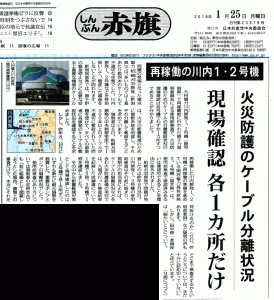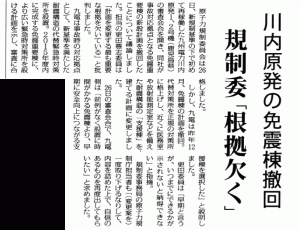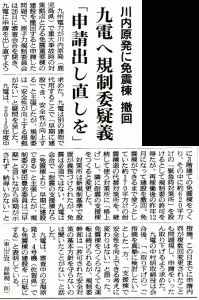Original Japanese written by staffer
The English below translated from the original Japanese by Heeday
The English translation edited by Rev. Dr. Henry French, ELCA
(Based on an article from the January 25th, 2016 edition of the Akahata newspaper)
▼Click the image and read the caption.

Japan’s Nuclear Regulation Authority (NRA) conducted a pre-use inspection of Units 1 and 2 of Kyushu Electric Power’s Sendai NPP (located in Kagoshima, southern Japan), before the two units were restarted. The inspection discovered that the power company had confirmed the separation of different cables at only one location, among the many such locations in each unit. This cable-from-cable separation is necessary to prevent a fire. This whole cable separation issue first emerged at TEPCO’s Kashiwazaki-Kariwa NPP, located in Niigata, some 150 miles NNW of central Tokyo. In some of the NPP’s units, several hundreds of cables were installed incorrectly in each unit. The NRA gave special treatment to some NPPs, such as Units 1 and 2 of the Sendai NPP, and failed to make complete inspections of them. We have to question the NRA’s attitude in this.
Japan’s new NPP regulatory standard requires installation of multiple systems of power cables connected to equipment that is crucial for safety, for instance, equipment necessary for an emergency stop of a reactor to reduce damages from a fire. And such cables must be separated from each other. On January 6th, 2016, in response to the discovery that more than a thousand cables were installed incorrectly under the central control room’s floor at the Kashiwazaki-Kariwa NPP, the NRA ordered every NPP operator to check on how cables had been installed at each NPP. However, Units 1 and 2 of Sendai and Units 3 and 4 of Kansai Electric Power’s Takahama NPP (located in Fukui, some 40 miles north of Kyoto), which is currently being prepared for a restart, were excluded from this cable check-up requirement, since a pre-use inspection had confirmed or was confirming the required cable separation.
There are voiced concerns over how effective such pre-use inspections really are. At a regular meeting of the NRA on January 6, a member of the NRA’s committee, Mr. Nobuhiko Ban, brought up a serious question: “In case the whole NPP operator’s organization tries to cover-up some wrongdoing, how can we detect it through only document inspections?” The Chairperson, Mr. Shun’ichi Tanaka, replied, “We still have work to do as we try to determine how detailed our inspections should be.”
(Based on an article from the January 27th, 2016 editions of the Asahi Shimbun and Akahata newspapers)
At the safety inspection meeting held by the NRA on January 26th, 2016, Kyushu Electric explained to the Authority, for the first time, that the power company had given up on the originally planned earthquake-proof building as the “emergency base,” which would have served as the field base for countermeasures in case of an accident at Units 1 or 2 of the Sendai NPP, located in Kagoshima. Kyushu Electric now hoped to do with a building having only some earthquake resistance instead. Responding to this, the NRA asked the power company to reconsider its restart plan, saying, among other things, “That change to the plan does not seem to improve safety.”
In the process of inspections for the Sendai NPP restart, Kyushu Electric originally announced that it would construct an earthquake-proof building (*) by the end of March 2016. In December 2015, shortly after the NPP’s two units restarted their operation, the power company all of a sudden changed the building plan. Now, it plans to continue using the small temporary emergency base that was originally built to serve until the earthquake-proof building was ready. The inspection for the Sendai NPP’s restart required construction of the earthquake-proof building, and the certificate of restart permission required it as well. Mr. Tanaka, chairperson of the NRA’s committee, revealed his suspicion that “Kyushu Electric might be concerned over passing the restart inspection alone, disregarding safety after the restart.”
There is an anti-nuclear citizen group named “Genkai Genpatsu Plu-Thermal to Zenbki wo Tomeru Saiban no Kai” (Plaintiff Group to Stop All the Units of Genkai NPP and Its MOX Operation), which blamed the power company for changing the plan to build an earthquake-proof building. The citizen group’s chairperson, Ms. Hatsumi Ishimaru, pointed out, “This issue (of the change in the building plan) reveals how serious the NRA is. The Authority should have suspended the restart permission, not just refusing to permit the building plan change. Whatever is inconvenient about a NPP restart can be ‘changed’ after the restart permission is given. Such a precedent must not be made.”
Behind those press reports, we see the attitude of both power companies and the NRA—“Just restart NPPs, and we can handle problems after that.” Japan’s government is striving to accelerate NPP restarts, shutting its eyes both to the victims of the Fukushima Daiichi meltdown, who are still living in agony, and to the majority of the nation’s people who are opposed to NPP restarts.
I believe that we, the people, have to watch carefully what the NRA and the power companies are doing, and we must speak out against restarts. We must not let the “NPP safety myth,” which convinced many of us before the Fukushima Daiichi meltdown, rise again.
** Earthquake-proof building — When a major earthquake hit central Niigata in 2007, at the Kashiwazaki-Kariwa NPP, located within the hard-hit area, the office building was damaged and became unusable. This incident taught the operator, TEPCO, a lesson and the power company constructed an earthquake-proof building at its NPPs. When Fukushima Daiichi was melting down, its earthquake-proof building played a crucial role as the emergency base for counteractions. Such a building has an earthquake-proof mechanism to drastically alleviate its shaking in case of an earthquake. The building also features power generators, communications equipment, radiation protection gear, as well as a rest area, storage rooms, etc. Though the latest NPP regulations do not require such a building, NPP operators are building them at many NPPs in Japan.


